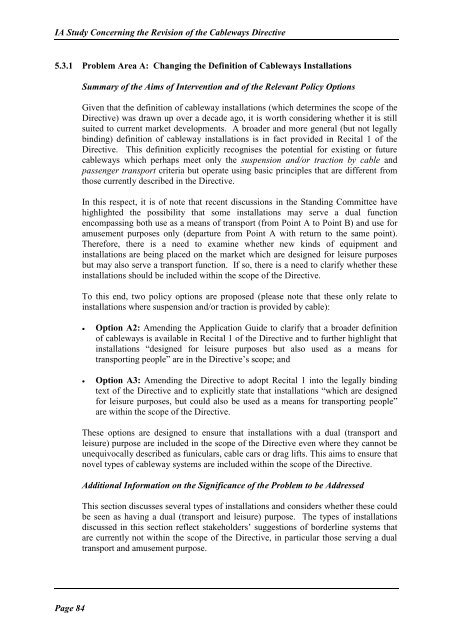Cableways Impact Assessment Study - Final Report - saferail.nl
Cableways Impact Assessment Study - Final Report - saferail.nl
Cableways Impact Assessment Study - Final Report - saferail.nl
Create successful ePaper yourself
Turn your PDF publications into a flip-book with our unique Google optimized e-Paper software.
IA <strong>Study</strong> Concerning the Revision of the <strong>Cableways</strong> Directive<br />
5.3.1 Problem Area A: Changing the Definition of <strong>Cableways</strong> Installations<br />
Summary of the Aims of Intervention and of the Relevant Policy Options<br />
Given that the definition of cableway installations (which determines the scope of the<br />
Directive) was drawn up over a decade ago, it is worth considering whether it is still<br />
suited to current market developments. A broader and more general (but not legally<br />
binding) definition of cableway installations is in fact provided in Recital 1 of the<br />
Directive. This definition explicitly recognises the potential for existing or future<br />
cableways which perhaps meet o<strong>nl</strong>y the suspension and/or traction by cable and<br />
passenger transport criteria but operate using basic principles that are different from<br />
those currently described in the Directive.<br />
In this respect, it is of note that recent discussions in the Standing Committee have<br />
highlighted the possibility that some installations may serve a dual function<br />
encompassing both use as a means of transport (from Point A to Point B) and use for<br />
amusement purposes o<strong>nl</strong>y (departure from Point A with return to the same point).<br />
Therefore, there is a need to examine whether new kinds of equipment and<br />
installations are being placed on the market which are designed for leisure purposes<br />
but may also serve a transport function. If so, there is a need to clarify whether these<br />
installations should be included within the scope of the Directive.<br />
To this end, two policy options are proposed (please note that these o<strong>nl</strong>y relate to<br />
installations where suspension and/or traction is provided by cable):<br />
<br />
<br />
Option A2: Amending the Application Guide to clarify that a broader definition<br />
of cableways is available in Recital 1 of the Directive and to further highlight that<br />
installations “designed for leisure purposes but also used as a means for<br />
transporting people” are in the Directive’s scope; and<br />
Option A3: Amending the Directive to adopt Recital 1 into the legally binding<br />
text of the Directive and to explicitly state that installations “which are designed<br />
for leisure purposes, but could also be used as a means for transporting people”<br />
are within the scope of the Directive.<br />
These options are designed to ensure that installations with a dual (transport and<br />
leisure) purpose are included in the scope of the Directive even where they cannot be<br />
unequivocally described as funiculars, cable cars or drag lifts. This aims to ensure that<br />
novel types of cableway systems are included within the scope of the Directive.<br />
Additional Information on the Significance of the Problem to be Addressed<br />
This section discusses several types of installations and considers whether these could<br />
be seen as having a dual (transport and leisure) purpose. The types of installations<br />
discussed in this section reflect stakeholders’ suggestions of borderline systems that<br />
are currently not within the scope of the Directive, in particular those serving a dual<br />
transport and amusement purpose.<br />
Page 84
















